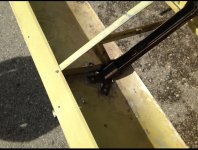Lowleveldevil
MEMBER
What is the best way or product to corrosion proof your assembled super cub wings internally before you cover.
You are correct on steel but with aluminum in a humid environment primer can keep the aluminum from corroding.Gotta ask. Why? Priming is a prep coat for a top coat. I recall a discussion here about priming airframes and the consensus was primer required a top coat to protect the airframe. Why prime surfaces not intended to be finished?
I like Variprime on leading edges. Internals didn't get coated.
From my Steel Structures Painting Council days, this would be due to the anchor pattern created in the surface during the blasting process on the frame. The primer may/will not cover it sufficiently and when it cures, the peaks of the anchor pattern can poke thru and rust. Not to say someone hasn't ever but I've never seen sand blasted aluminum so no peaks = no "salt and pepper" corrosion. Now proper adhesion without an anchor pattern to grab ahold of takes a good epoxy primer and good cleaning prep.Gotta ask. Why? Priming is a prep coat for a top coat. I recall a discussion here about priming airframes and the consensus was primer required a top coat to protect the airframe. Why prime surfaces not intended to be finished?
Stewart Systems epoxy primer. View attachment 51249
In 1966 my mechanic said "just fog everything with zinc chromate (no longer available here). I did. Still no visible corrosion. Four miles from ocean, but Mediterranean climate.
I've been debating this with a set of built-up Javron wings. I'm using the Stewart covering system and have debated whether or not to shoot a protective coat on all exposed surfaces, which would be a nightmare. Intend to keep the plane on wheels, so float plane consideration not an issue. Guess everyone is going their own way on this.
Fresh water use is also not a float plane issue. More importantly is the atmospheric environment where the plane will live. If it will live in a coastal, highly humid and/or acidic environment protect it. If it lives in a dry desert, forget it. In between use your own judgement. Give us a clue as to your location. Then we can give you a more accurate answer.I've been debating this with a set of built-up Javron wings. I'm using the Stewart covering system and have debated whether or not to shoot a protective coat on all exposed surfaces, which would be a nightmare. Intend to keep the plane on wheels, so float plane consideration not an issue. Guess everyone is going their own way on this.




